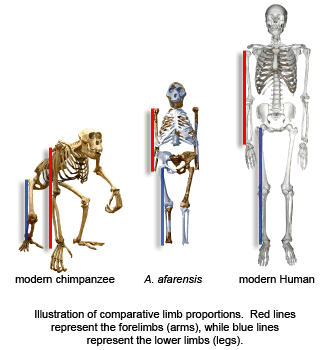An animal’s limb proportions can provide clues as to what mode of locomotion an animal utilizes on a regular basis. A ratio of limb proportions is calculated by dividing the forelimb length (humerus length + radius length) by the length of the hindlimb (femur length + tibia length). This ratio is called an intermembral index (“inter” means “between”, “membral” means “limb”). Look at the picture (left) and examine the length of the red lines that highlight the forelimbs relative to the hindlimbs.
 Humans have an intermembral index between 68-7011, meaning that their hindlimbs are longer than their forelimbs. A low intermembral index in humans reflects the fact that they rely exclusively on their hindlimbs for propulsion during bipedal walking. Chimpanzees have an intermembral index of 10612, meaning that their forelimbs are longer than their hindlimbs. A high intermembral index in chimpanzees reflects the fact that they rely heavily on their forelimbs for climbing and arm-hanging/swinging activities. Lucy's intermembral index is 8811. Thus, Lucy appears to have an intermediate measurement between modern humans and chimpanzees. Measurements of the individual bones in the index show that Lucy’s intermediate body proportions are a result of a shortened humerus. Since the evolutionary trend in hominins is toward relatively longer hindlimbs than forelimbs, as in modern humans, Lucy’s skeleton shows that arm length reduced before thigh elongation2. Functionally, Lucy probably relied on her hindlimbs for moving bipedally and on her forelimbs for climbing.
Humans have an intermembral index between 68-7011, meaning that their hindlimbs are longer than their forelimbs. A low intermembral index in humans reflects the fact that they rely exclusively on their hindlimbs for propulsion during bipedal walking. Chimpanzees have an intermembral index of 10612, meaning that their forelimbs are longer than their hindlimbs. A high intermembral index in chimpanzees reflects the fact that they rely heavily on their forelimbs for climbing and arm-hanging/swinging activities. Lucy's intermembral index is 8811. Thus, Lucy appears to have an intermediate measurement between modern humans and chimpanzees. Measurements of the individual bones in the index show that Lucy’s intermediate body proportions are a result of a shortened humerus. Since the evolutionary trend in hominins is toward relatively longer hindlimbs than forelimbs, as in modern humans, Lucy’s skeleton shows that arm length reduced before thigh elongation2. Functionally, Lucy probably relied on her hindlimbs for moving bipedally and on her forelimbs for climbing.
eFossils is a collaborative website in which users can explore important fossil localities and browse the fossil digital library. If you have any problems using this site or have any other questions, please feel free to contact us.
Funding for eFossils was provided by the Longhorn Innovation Fund for Technology (LIFT) Award from the Research & Educational Technology Committee (R&E) of the IT governance structure at The University of Texas at Austin.
